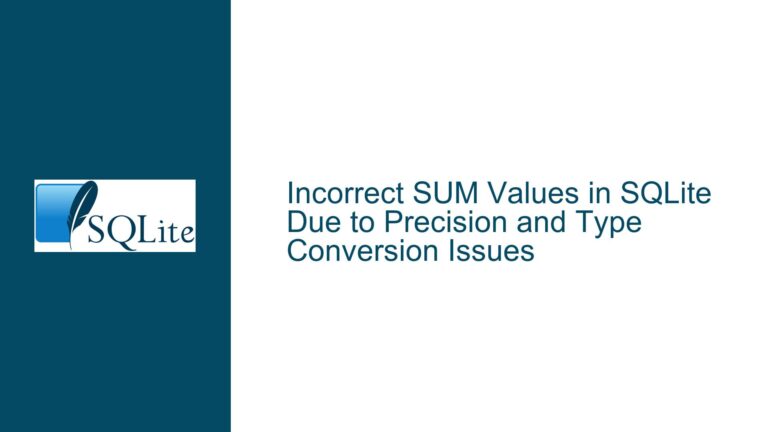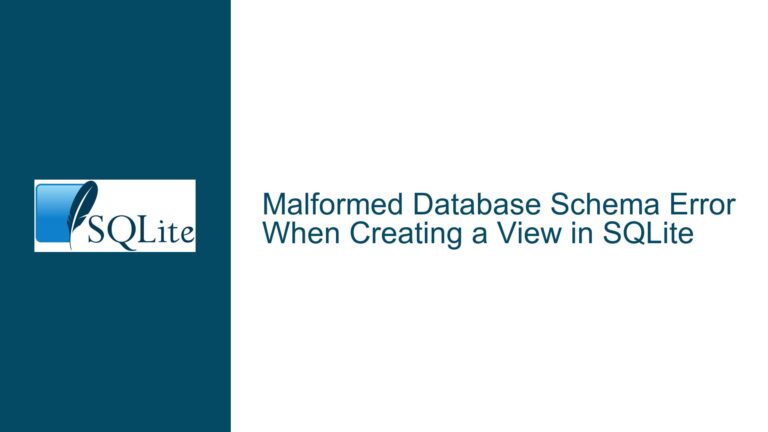Resolving Ambiguous Column Names in SQLite Queries
Understanding Column Name Resolution in SQLite Queries
When working with SQLite, one of the most common issues that developers encounter is the resolution of column names in queries, especially when dealing with subqueries, joins, or multiple tables with overlapping column names. The problem arises when a column name is referenced without sufficient qualification, leading to ambiguity. SQLite, like other relational databases, follows a specific set of rules to resolve column names, but understanding these rules is crucial to avoid errors and ensure that your queries behave as expected.
In SQLite, column names can be referenced in several ways: as bare column names, qualified with a table name, or fully qualified with a schema name. The resolution of these references depends on the context in which they are used. If a column name is ambiguous—meaning it could refer to more than one column in the same scope—SQLite will raise an error. This error is a safeguard to prevent unintended behavior, but it can be frustrating if you don’t understand why it’s happening or how to fix it.
The core issue here is that SQLite does not guess which column you are referring to when a name is ambiguous. Instead, it requires you to explicitly specify the table or schema to which the column belongs. This behavior is by design, as it ensures that the database engine executes exactly what you intend, rather than making assumptions that could lead to incorrect results.
Why Ambiguous Column Names Cause Errors in SQLite
Ambiguous column names occur when a query references a column that exists in more than one table within the same scope. For example, consider a query that joins two tables, orders and customers, both of which have a column named id. If you write a query that references id without specifying which table it belongs to, SQLite will not be able to determine whether you mean orders.id or customers.id. This ambiguity results in an error, preventing the query from being executed.
The error message you receive will typically indicate that the column reference is ambiguous, and it will ask you to qualify the column name with a table name or alias. This is SQLite’s way of ensuring that the query is unambiguous and that the results are predictable. While this behavior is strict, it is necessary to maintain the integrity of the data and the correctness of the query results.
One of the challenges with ambiguous column names is that they can be difficult to spot, especially in complex queries with multiple joins and subqueries. If you are not careful, you might inadvertently reference a column that exists in more than one table, leading to an error that can be hard to diagnose. This is why it is important to understand how SQLite resolves column names and to follow best practices when writing queries.
Best Practices for Resolving Column Name Ambiguity in SQLite
To avoid issues with ambiguous column names, it is essential to follow a set of best practices when writing SQL queries. These practices will help you write clear, unambiguous queries that are easier to maintain and less prone to errors.
First, always qualify column names with the table name or alias when referencing columns in queries that involve multiple tables. This is especially important in queries with joins, subqueries, or nested queries. By explicitly specifying the table name, you eliminate any ambiguity and ensure that SQLite knows exactly which column you are referring to.
Second, use table aliases to simplify your queries and make them more readable. Table aliases allow you to assign a short, meaningful name to a table, which you can then use to qualify column names. For example, instead of writing orders.id, you can assign an alias like o to the orders table and write o.id. This not only reduces ambiguity but also makes your queries easier to read and understand.
Third, be mindful of the scope in which column names are resolved. In SQLite, column names are resolved in a hierarchical manner, starting from the innermost query and moving outward. If a column name is not found in the current scope, SQLite will look for it in the next outer scope, and so on, until it reaches the outermost query. Understanding this resolution order can help you avoid unexpected behavior and ensure that your queries work as intended.
Finally, when designing your database schema, try to avoid using the same column name in multiple tables unless absolutely necessary. While this is not always possible, especially in large databases with many tables, it can help reduce the likelihood of ambiguity in your queries. If you do need to use the same column name in multiple tables, make sure to qualify the column names in your queries to avoid errors.
By following these best practices, you can write SQL queries that are clear, unambiguous, and less prone to errors. This will not only make your queries easier to maintain but also help you avoid the frustration of dealing with ambiguous column names in SQLite.
Troubleshooting Ambiguous Column Name Errors in SQLite
If you encounter an ambiguous column name error in SQLite, there are several steps you can take to troubleshoot and resolve the issue. The first step is to carefully review the error message, which will typically indicate which column name is ambiguous and in which part of the query the ambiguity occurs. This information can help you pinpoint the source of the problem and determine how to fix it.
Next, examine the query to identify all the tables and columns involved. Look for any instances where a column name is referenced without a table name or alias. If you find such instances, qualify the column name with the appropriate table name or alias to eliminate the ambiguity. For example, if you have a query that joins the orders and customers tables and references the id column, you should specify whether you mean orders.id or customers.id.
If the query involves subqueries or nested queries, pay close attention to the scope in which column names are resolved. Remember that SQLite resolves column names starting from the innermost query and moving outward. If a column name is not found in the current scope, SQLite will look for it in the next outer scope. This means that a column name in a subquery could inadvertently reference a column in an outer query, leading to unexpected behavior. To avoid this, always qualify column names in subqueries with the appropriate table name or alias.
In some cases, the ambiguity may be caused by a change in the database schema, such as adding a new column to an existing table. If a column name is added to a table that already exists in another table, queries that previously worked may suddenly start failing due to ambiguity. To prevent this, it is a good idea to review your queries whenever you make changes to the database schema and ensure that all column references are properly qualified.
Finally, if you are still unable to resolve the ambiguity, consider breaking the query down into smaller parts and testing each part individually. This can help you isolate the source of the problem and make it easier to identify and fix the issue. Once you have resolved the ambiguity in each part of the query, you can then combine them back into a single query.
By following these troubleshooting steps, you can effectively resolve ambiguous column name errors in SQLite and ensure that your queries work as intended. This will not only save you time and frustration but also help you write more robust and reliable SQL queries.
Conclusion
Ambiguous column names are a common source of errors in SQLite queries, but they can be easily avoided by following best practices and understanding how SQLite resolves column names. By always qualifying column names with the appropriate table name or alias, using table aliases to simplify your queries, and being mindful of the scope in which column names are resolved, you can write clear, unambiguous queries that are less prone to errors.
If you do encounter an ambiguous column name error, take the time to carefully review the error message, examine the query, and qualify the column names as needed. By following these steps, you can quickly resolve the issue and ensure that your queries work as intended. With a solid understanding of how SQLite handles column name resolution, you can write more efficient and reliable queries, making your work with SQLite more productive and enjoyable.






